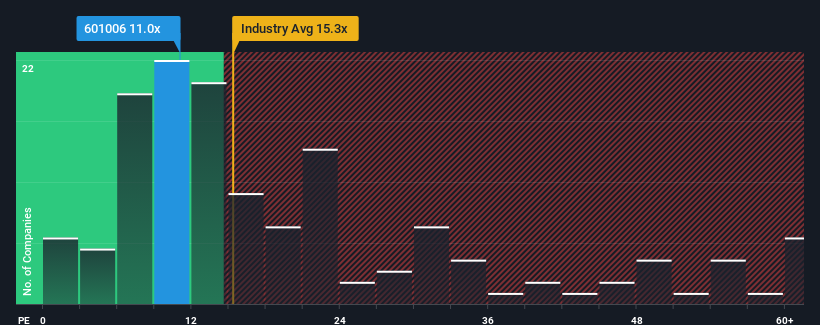- China
- /
- Transportation
- /
- SHSE:601006
Earnings Working Against Daqin Railway Co., Ltd.'s (SHSE:601006) Share Price

When close to half the companies in China have price-to-earnings ratios (or "P/E's") above 29x, you may consider Daqin Railway Co., Ltd. (SHSE:601006) as a highly attractive investment with its 11x P/E ratio. Although, it's not wise to just take the P/E at face value as there may be an explanation why it's so limited.
While the market has experienced earnings growth lately, Daqin Railway's earnings have gone into reverse gear, which is not great. It seems that many are expecting the dour earnings performance to persist, which has repressed the P/E. If this is the case, then existing shareholders will probably struggle to get excited about the future direction of the share price.
View our latest analysis for Daqin Railway

Is There Any Growth For Daqin Railway?
Daqin Railway's P/E ratio would be typical for a company that's expected to deliver very poor growth or even falling earnings, and importantly, perform much worse than the market.
If we review the last year of earnings, dishearteningly the company's profits fell to the tune of 9.8%. As a result, earnings from three years ago have also fallen 21% overall. Therefore, it's fair to say the earnings growth recently has been undesirable for the company.
Shifting to the future, estimates from the eleven analysts covering the company suggest earnings growth is heading into negative territory, declining 2.8% per annum over the next three years. Meanwhile, the broader market is forecast to expand by 24% per annum, which paints a poor picture.
With this information, we are not surprised that Daqin Railway is trading at a P/E lower than the market. Nonetheless, there's no guarantee the P/E has reached a floor yet with earnings going in reverse. There's potential for the P/E to fall to even lower levels if the company doesn't improve its profitability.
The Key Takeaway
Generally, our preference is to limit the use of the price-to-earnings ratio to establishing what the market thinks about the overall health of a company.
As we suspected, our examination of Daqin Railway's analyst forecasts revealed that its outlook for shrinking earnings is contributing to its low P/E. At this stage investors feel the potential for an improvement in earnings isn't great enough to justify a higher P/E ratio. Unless these conditions improve, they will continue to form a barrier for the share price around these levels.
Don't forget that there may be other risks. For instance, we've identified 2 warning signs for Daqin Railway that you should be aware of.
If P/E ratios interest you, you may wish to see this free collection of other companies with strong earnings growth and low P/E ratios.
New: Manage All Your Stock Portfolios in One Place
We've created the ultimate portfolio companion for stock investors, and it's free.
• Connect an unlimited number of Portfolios and see your total in one currency
• Be alerted to new Warning Signs or Risks via email or mobile
• Track the Fair Value of your stocks
Have feedback on this article? Concerned about the content? Get in touch with us directly. Alternatively, email editorial-team (at) simplywallst.com.
This article by Simply Wall St is general in nature. We provide commentary based on historical data and analyst forecasts only using an unbiased methodology and our articles are not intended to be financial advice. It does not constitute a recommendation to buy or sell any stock, and does not take account of your objectives, or your financial situation. We aim to bring you long-term focused analysis driven by fundamental data. Note that our analysis may not factor in the latest price-sensitive company announcements or qualitative material. Simply Wall St has no position in any stocks mentioned.
Have feedback on this article? Concerned about the content? Get in touch with us directly. Alternatively, email editorial-team@simplywallst.com
About SHSE:601006
Daqin Railway
Provides railway transportation services in the People’s Republic of China and internationally.
Excellent balance sheet and good value.
Market Insights
Community Narratives



